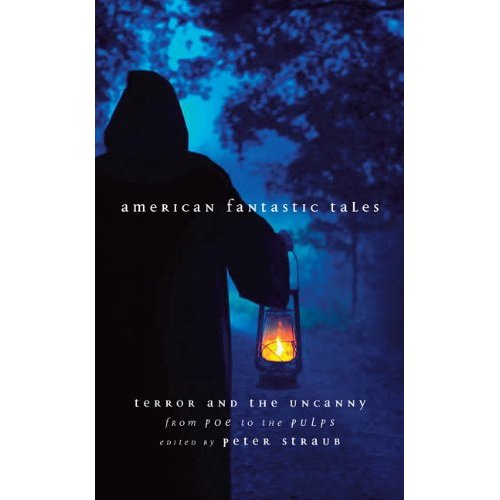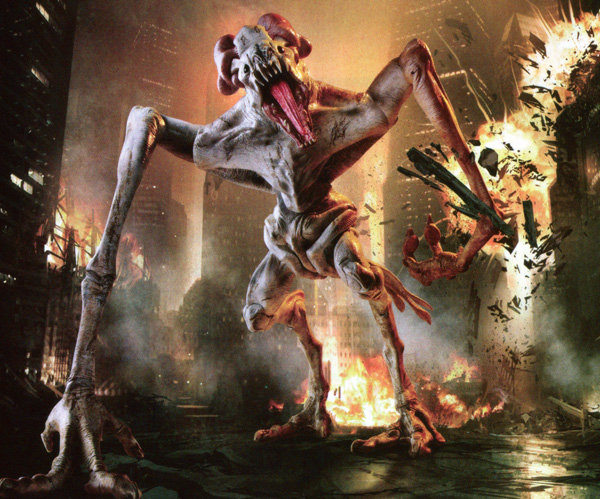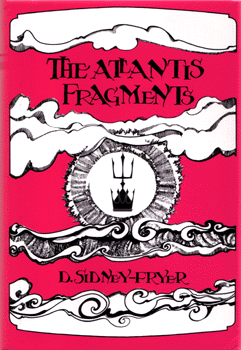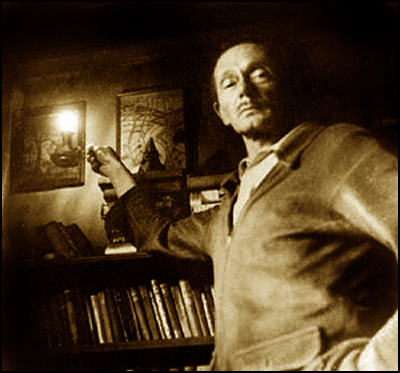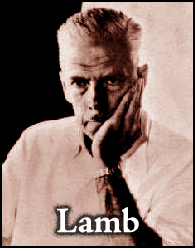One of the most welcome books to appear for fans of weird fiction in 2003 was The Selected Letters of Clark Ashton Smith, published by Arkham House and edited by David E. Schultz and Scott Connors. Finally, the third member of the great Weird Tales triumvirate is revealed in correspondence. Talking about his stories, his relationships, his life, Smith is as fascinating as Howard and Lovecraft have always been in their letters.
Although none of the letters Smith wrote to Howard are in the collection (presumably because they have not survived into the present day) Howard is nevertheless mentioned in several of the letters to HPL, Derleth, and others. Smith’s comments are perceptive and largely positive of Howard and his work, and they are surely of interest to Howard fans.
The first mention occurs in Letter #107 on page 122, which is a letter to H. P. Lovecraft dated circa late October 1930. Smith is discussing Wright’s frustrating editing choices:
Wright is certainly capricious in his rejections and acceptances; though I, for one, am the last to blame him for trying to please his public. But it seems to me that he makes mistakes even from this view-point. I thought the last issue of W.T. rather punk, apart from the verses, the frontispiece decoration by Senf, and one or two fine passages in Howard’s tale. I couldn’t stomach this last as a whole — that bloody battle stuff is so stale that it gives me what Sterling called “the Molossian pip.” Still, it was better than Hamilton’s current re-dishing of his immemorial moth-eaten plot, and the commonplace detective thriller by Quinn. Munn’s story was vivid and original in some of its detail, but I didn’t get much out of it as a whole. And even the reprint was pretty tame.
Keep this low opinion of Howard’s blood-and-thunder in mind, because Smith would revise it later after corresponding with Howard and discovering the weird ecstasies inherent in his Conan tales.
Later on in the same letter he makes an interesting comment regarding Literature in general:
As for the problem of phantasy, my own standpoint is that there is absolutely no justification for literature unless it serves to release the imagination from the bounds of every-day life.
On page 176 is a footnote stating that a book Smith had recently received, The Horrid Mysteries by Karl Grosse (1768-1847), had been mentioned by Howard in his story “The Children of the Night.”
Letter #156 is to August Derleth dated Oct. 8th, 1932, and the opening paragraph on page 193 is as follows:
Dear August:
I am glad that Wright took “The Carven Image,” and shall look forward to seeing it in print. His ideas of deadwood must be peculiar, considering the amount of it that he admits into the magazine. In the current issue, Howard’s “Worms of the Earth” seems to be the one real first-rater.
The footnotes to this letter say that “Worms” appeared in the November 1933 issue. This is incorrect; it was November 1932.
On page 199 is Letter #160, from CAS to August Derleth, dated February 1st, 1933. CAS begins by once again criticizing Wright:
W. finally sent back “The Third Episode of Vahtek,” saying that he saw opportunity of using it at present, but might possibly ask me to re-submit it at some future time. Oh well. . .
Then a bit later he once again breaks down his impression of the latest Weird Tales:
The current W.T. impresses me as being an excellent issue, apart from the banality of the cover. I like the tales by Howard, Eadie and Ernst, especially the former. Quinn’s tale was altogether too hackneyed. . .
The Howard tale had been “The Tower of the Elephant,” and the “banal” cover had been by Margaret Brundage. As we will see, CAS was a champion of Howard’s Conan character, seeing the tales as extraordinarily “weird” in the best sense.
Letter #174, again to August Derleth, was dated August 29th, 1933. By this time Smith has began his own correspondence with Howard, after having heard of him through Lovecraft for several years. He states:
Howard is a rather surprising person, and I think he is more complex, and is also possessed of more literary ability, than I had thought from many of his stories. The Conan tales, in my opinion, are quite in a class by themselves. H. seemed very appreciative of my book of poems, Ebony and Crystal, and evidently understood it as few people have done.
Mull that one over for a moment, folks. Here we have Smith reevaluating his previous opinion of Howard as a fine writer whose work was too often marred by cookie-cutter plots of violence and battle. Suddenly, after reading some of Howard’s letters, he is beginning to see the thematic core of the man, and therefore the depth of his stories that was previously hidden to him. For Howard’s part, he is “getting” Smith in the same manner, which Smith is not used to and which surprises him, coming as it is from the Two-Gun Texan who he thought was shallower than that. It is my contention that for all their faults, the three great Weird Tales writers all understood each other’s greatness, they realized in their own lifetimes that the three of them were special. Whereas hopeless types like S. T. Joshi will go their whole lives without discerning the true undercurrents of these relationships and the fusion of their life’s work, despite writing thousands of pages of ostensibly illuminating commentary.
Dateline mid-October 1933. Letter #179, to H. P. Lovecraft, titled “From the room embossed and paved with demon faces, in the subterranean palace of Haon-Dor.” Smith once again delves into the current Weird Tales and rates the stories:
I hope to peruse “The Thing on the Door-Step” when you get around to typing it. In spite of your disparagement, “The Festival” holds its place in my affections, and has an imaginative quality that puts it above the new stories in the current W.T. Howard has some fine romantic fantasy in “The Pool of the Black Ones”[sic]; and Long’s tale has the makings of more than a pot-boiler. With more concentration on development and detail, it would have been first-rate. I must re-read the story by Merle Prout. I liked the idea and some of the incidents; but certain crudities rather jarred upon me in the hasty perusal which I gave it. My own tale was chiefly conspicuous for certain scientific horror-touches, carefully accumulated; and if the idea of flesh-eating plants weren’t so hackneyed it would deserve a higher place.
I find this a valuable addendum to my thoughts of the last letter excerpt. Namely here we see HPL having disparaged one of his very best tales, “The Festival,” and Smith stepping in to correct what is either HPL’s self-modesty or inability to judge his own work (probably the latter, a problem Howard often shared). Then not a moment after bucking up Lovecraft, Smith does some disparaging of his own story, as usual deeming the plot too overused. I think Smith is wrong to do so; plots are ultimately mere window dressing for the story. They are a dime a dozen, overused in every venue, yet tales achieve their uniqueness not from plot but from the author’s sensibilities seeping into the execution of the telling of the story. All of the Conan tales have fairly derivative plots, yet Howard’s focus on barbarism and the decay of civilization elevate those plots into something new, they say things that haven’t ever been said in quite that way, even as the plot looks painfully familiar to narrow-minded readers.
A short Howard reference is to be had on page 236, during Letter #182 from CAS to HPL ca. early November 1933. Smith writes:
Yes, I noticed W’s plural mention of The Black Book & Unaussprechlichen Kulten. Shades of Von Junzt!
Of course, it was Robert E. Howard who invented this book and the book’s author, which have since become two of the most famous and popular invented aspects of the Cthulhu Mythos.
On page 239 we have another short mention of Howard, this time in Letter #183 to HPL dated c. 4 December 1933. CAS has just read Lovecraft’s “The Thing on the Doorstep” several times, and has come away impressed. When Lovecraft sent stories to friends in manuscript form, the story would go from correspondent to correspondent in a loosely-knit circle, of which Howard was a part. CAS thus writes:
I trust that Conan and most of the others on the circulation list fully appreciate the treat in store for them. The ms. goes forward to the Cimmerian monarch today.
In late January 1934 Smith wrote another letter to HPL, in which he dissected the latest Weird Tales, singling out Howard for praise:
Howard Wandrei’s tale in the last W.T. was quite good and original, I thought. Conan, as usual, put on a very entertaining and imaginative show. Merritt’s “Woman of the Wood,” though excellent, impressed me as being somewhat overrated. The other tales in this issue were hardly noteworthy.
The Conan tale Smith had read was “Rogues in the House.”
Smith received a volume in the Not at Night anthology series in late February 1934, and wrote Lovecraft about it in Letter #187. On page 251 of the Selected Letters book he tells us:
I received also the new Not at Night anthology, Keep on the Light, and was struck by the immense superiority of the items taken from Weird Tales, over others which, I presume, are by British authors. Howard’s “Worms of the Earth” and Whitehead’s “The Chadbourne Episode” were the leaders.
On page 275 in Letter #202, this one to R. H. Barlow dated November 23rd 1936. It is the first mention of Howard by CAS in this volume since his suicide five months earlier. This was the beginning of the end for the Weird Tales Golden Age. Howard was dead; Lovecraft was a few months away from his own death, and Smith would leave the field, devastated by the loss of his peers and bedeviled by his own personal troubles.
At one point in the letter he talks to Barlow about various life troubles, and while Howard is not brought up his ghost hangs palpably over the proceedings:
I am damnably sorry to learn, both from your letter of last June and Ech-Pi-El’s more recent letters, the troubles and difficulties that you have been having. Such matters are beyond our control, and it would seem the misfortunes have a way of “ganging up” on the victim: at least, that has been my own experience. I have had enough grief, the past two years, to founder a dreadnought and am beginning to wonder if sea-bottom has yet been reached!
A bit later comes the Howard reference, where CAS writes:
Which reminds me, before I pass to other matters, that I greatly liked your sonnet-tribute to R.E.H. in the pages of our old standby.
This sonnet, titles simply “R.E.H.,” appeared in the October 1936 number of Weird Tales. Barlow was a more careful observer of Howard’s end than most others at the time; Barlow himself would take his own life years later.
A short time later, on November 27 1936, CAS wrote to HPL, in the course of which he commented that:
Howard’s death startled and shocked me as it must have shocked everyone else. It is understandable but infinitely tragic and regrettable. . .Sometimes, though, the anticipation of an event is more unbearable than the event itself; and I wonder if Howard might not have pulled through if the nurse had been less frank.
I admired Barlow’s memorial sonnet greatly. Your prose tribute, and that of Price, were fine.
But soon, HPL too would be lost. On March 23, 1937 CAS wrote to August Derleth about the death of Lovecraft a few weeks earlier on March 15 of intestinal cancer:
Dear August:
The news of Lovecraft’s death seems incredible and nightmarish, and I cannot adjust myself to it. . .it saddens me as nothing has done since my mother’s death; and, somehow, I can’t help feeling that it should have been unnecessary.
[. . .]
It is all too melancholy; and it would be no less futile than needless to expatiate on the loss to us who are left.
A week later, Derleth had decided on a plan to preserve all of Lovecraft between hardcovers, the genesis of what would soon become Arkham House. He asked Smith for information on the Cthulhu Mythos, and Smith’s reply contains the next Howard reference, in Letter #209 dated April 13 1937. Speaking of the mentions of various Cthulhuoid deities, Smith notes that:
Hastur is mentioned in “The Whisperer in Darkness,” in a listing of fabulous names that includes Bethmoora (from Dunsany) and L’mur-Kathulos and Bran (partially or wholly from R. E. Howard: though there is also a Bran in Celtic mythology).
One of the absolutely most fascinating quotes about Howard that I have ever read came on page 302, at the conclusion of a long letter to Robert Barlow dated May 16, 1937. It staggers the knowledgeable reader by virtue of it’s revelation of the forces that drove the last of the Weird Tales greats out of fiction writing, and for the truly perceptive readings the three greats gave each other’s work. Before we saw CAS marvel at Howard understanding his poetry as few others ever had; now witness Smith paying Howard the same compliment, albeit posthumously:
Writing is hard for me, since circumstances here are dolorous and terrible. Improvement in my father’s condition is more than unlikely, and I am more isolated than ever. Also, I seem to have what psychologists call a “disgust mechanism” to contend with: a disgust at the ineffable stupidity of editors and readers. I think that some of my best recent work is sculpture: and I find myself confronted with another blank wall of stupidity. Oh well and oh hell: some one will make a “discovery” when I am safely dead or incarcerated in the bughouse or living with a yellow gal in Cambodia.
Yours for the bombing of Philistia and Boetia with Chinese stinkpots,
Clark Ashton
P.S. On glancing over this letter, I note a few asperities of tone, and, in places, a lack of Arnoldian “sweetness and light.” In extenuation, I must plead that I have been pretty much at the boiling point lately.
I believe the late R. E. Howard and I would have had a grand time together lambasting civilization; that is, if I have not been misinformed as to his views. Barbarism, barbaric art, barbaric peoples, appeal more and more to me. I could never live in any modern city, and am more of an “outsider” than HPL. His “outsideness” was principally in regard to time-period; mine is one of space, too.
My God, think of what might have occurred had Howard somehow survived, and after the death of Lovecraft he and Smith struck up a far more intense correspondence, making up for the loss of HPL with a stronger link to each other. How perfect is it to see how Howard influenced and inspired the likes of CAS as much if not more than those people affected REH. REH is generally seen as dispensable in the greater schema of the Lovecraft Circle. His views contrary to the cosmicism practiced by the rest of the group, he often is dismissed as a hanger-on of sorts, the Gilligan of the group. Don Herron has acutely pointed out in the past Lovecraft’s stellar use of Howardian action in his masterpiece “The Shadow of Innsmouth,” opining that HPL could never have brought himself to that great a boil without his furious correspondence with Howard fueling his creativity at the same time, subtly influencing his writing the same way traces of Lovecraft crept into Howard’s writing. Now, we get to add to that the wonderful fancy of Clark Ashton Smith slaving away on his curious sculptures that would become one of the famous cornerstones of his artistic legend, the whole time grumbling about civilization and thinking of Howard and his Cimmerians, those images ultimately affecting the primitive grandeur of the carvings. Wonderful.
The last mention of Howard in the volume of letters is also of more than cursory interest, for it provides another nugget of Howard lore which to date I had never heard, or don’t remember hearing. Letter #217 is to Barlow on July 12th, 1937, and begins with mention of a new fan publisher on the block:
Glad to hear that the booklet impressed you so favorably. (Mr.) Claire P. Beck, aged nineteen, is the printer; address, Box 27, Lakeport Cal. . .He is desirous of bringing out a book of R. E. Howard’s stories, and also a selection of mine.
So now we have word of a Mr. Claire Beck (1919-1999) (who ran an amateur printing operation with his two brothers, Groo (?!?!) and Clyde) wanting to print a Howard volume during the same time Derleth and Wandrei were desperately trying to get Arkham House off of the ground. As it turned out, Derleth and Wandrei were the Johnnys-on-the-spot, succeeding where so many other fans failed. But between this little tidbit, along with the cryptic mention in an OAK to Dr. Howard letter of someone possibly being interested in collecting the Conan stories and/or the Costigan stories circa 1937, and with items such as Paul Spencer’s plea to reprint Howard (currently in print in The Barbaric Triumph) thrown in, it’s clear that Howard was as viable a commodity as Lovecraft during those years, with only luck and the vagaries of the marketplace nudging Lovecraft into print first via Arkham House.
The Selected Letters of Clark Ashton Smith is a must-buy for any fan of Robert E. Howard, as it fills in large gaps in the knowledge of one of Howard’s best literary compatriots, gaps that serve to broaden one’s formulation of the entire weird fiction and pulp scene during those years. It’s obvious to me that someday a book combining the lives of all three Weird Tales geniuses — Howard, Lovecraft, and Smith — will have to be written. There is far too much spectacular material not to give it a try. All three authors deserve to ascend through the literary ranks together, for together they fed off of each other’s talents and momentum, and their combined corpus is far more potent and rich than any one of them alone. Whoever first called them the Three Musketeers was prescient in the extreme, for truly in a literary sense they remain “All for one, and one for all.”


